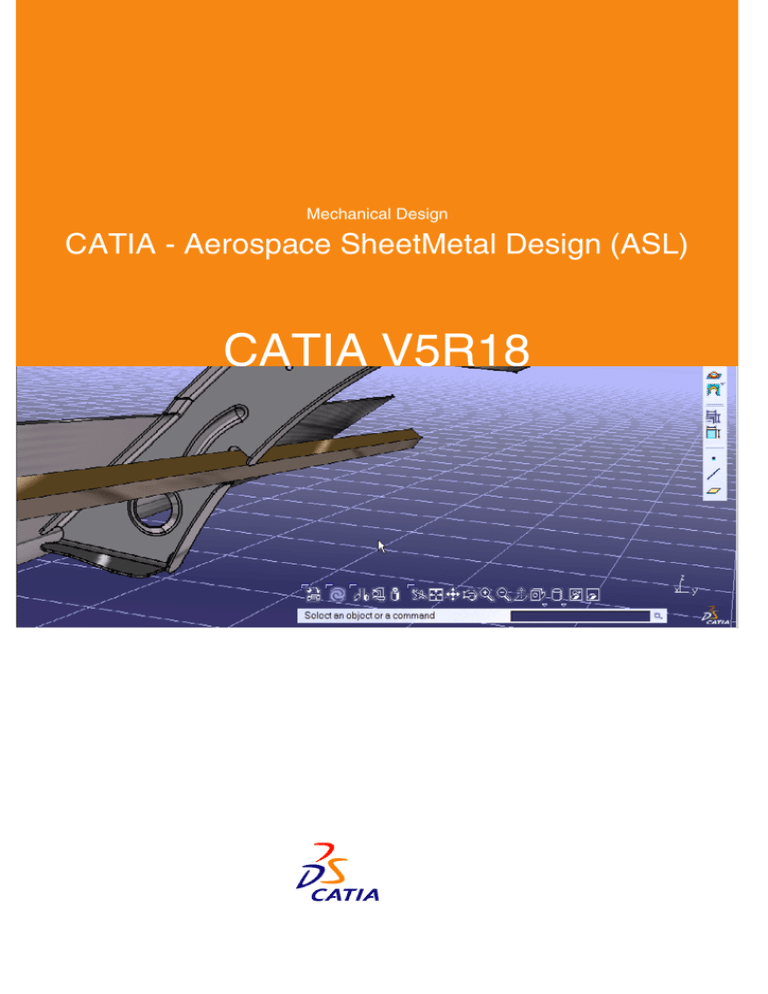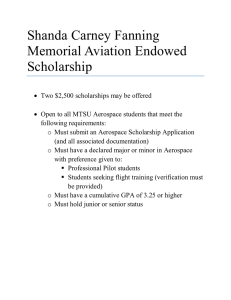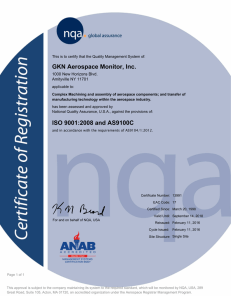
Mechanical Design
CATIA - Aerospace SheetMetal Design (ASL)
CATIA V5R18
Mechanical Design
CATIA - Aerospace SheetMetal Design
Designs (hydro-pressed or break-formed) sheet metal parts used in the
aerospace industry.
Product overview
CATIA Generative Aerospace Sheetmetal
Design is a product dedicated to the
definition of sheetmetal parts used in the
aerospace industry (hydro-pressed or
break-formed).
It enables the capture of company
knowledge,
including
design,
and
manufacturing constraints.
Product is based on Feature Modeling
techniques, using a pre-defined set of
Features used for sheetmetal parts
designed in the aerospace industry.
Based on both specification-driven and
generative approaches, this product will
allow typical hydro-formed aerospace
parts to be easily specified, the system
taking care of creating both 3D and
flattened part geometry. Where such parts
are designed or modified with basic
modeling tools within hours or days, this
product allows same result to be achieved
in minutes.
CATIA Generative Aerospace Sheetmetal
Design provides an interactive function to
design sheetmetal parts in a very intuitive
way, taking manufacturing constraints into
accounts. It provides the flatpattern of the
sheetmetal
part,
and
allows
easy
incremental design (from preliminary to
detailled stages) and modification both in
3D and flattened conditions.
Whenever
initial
specifications
are
changed (e.g. the aircaft skin on which a
frame has been designed is modified), this
product will allow new part to be
automatically rebuild,
specifications.
based
on
new
Product Highlights
Associative and dedicated SheetMetal
feature-based modeling
Creates and manages sheetmetal parts
through specifications (feature based
techniques based on solids, surfaces &
wireframe geometry, and technological
attributes)
Folding and unfolding capabilities
Concurrent engineering between the
unfolded or folded part representation
Dedicated aerospace features available
include Web, Flange (curved, double curved
or planar), Joggle, Cutout, Stiffening bead,
extruded hole
Compute automatically 3D folded part and
2D flattened part geometry from technical
specifications
Enables simple creation/modification of
sheetmetal elements through change in
specifications, the update of geometry
automatic
Copyright © 2002-2004 Dassault Systemes - All rights reserved
2
Provides bend allowance computation
when flattening through user-defined neutral
fiber
Company standards and skills can be
used to specify features through CATIA V5
Knowledge abilities
Encapsulates Feature Based Modeling
and makes it available through a handy
user-interface dedicated to Sheetmetal for
Aerospace
Product Key Customers Benefits
Specification-Based Design...
Using
feature-based techniques and technological
attributes, aerospace designers can quickly
create sheet metal parts (hydro-pressed or
break-formed) with Generative Aerospace
Sheetmetal Design. The intelligent tools of this
system enable designers to generate and
modify their models, such as frames, within
minutes instead of hours or days.
Automated Modification capabilities...
Designers can effect modifications through
changes to defined features and technological
attributes or direct geometry manipulation. As
designers make changes in specifications, the
system automatically updates the geometry.
Flexible Solution... Generative Aerospace
Sheetmetal Design allows designers to switch
from one representation -- whether solids or
surfaces -- to another whenever they want.
Users can create and modify their design as a
3D formed part or a 2D flat pattern. Due to the
design approach's flexibility, users can initially
define the part through major functional
characteristics that comply with the part's
general dimensions. Later, the designers can
add holes and cutouts for access as well as
place components and fasteners.
Associativity between the flattened and
formed part ensures accuracy of design
details
and
helps
designers
ensure
manufacturability.
Associativity
is
also
maintained with the drawings. This integration
of aerospace sheetmetal parts into the
drafting environment avoids duplicate part
definition, thereby increasing data integrity.
Dedicated Aerospace Interface...
With
Generative Aerospace Sheetmetal Design
designers work with familiar aerospace
features enabling them to concentrate on their
design
project.
Some
of
these
aerospace-specific design features include:
Web
Flange (curved, double curved or planar)
Flange cutout
Flanged hole
Flanged slot
User Flange
Joggle
Slot
Cutout
Stiffening bead
Stiffening Rib
Corner relief
Hole
Stamp
Planar Flange
Tear Drop
Hem
Captured Company Expertise... Users are
able to create files with defined corporate
standards for such features as holes,
stiffening beads or lightening holes. As many
files as necessary can be created for different
materials, machines, or projects. This enables
CATIA users to take advantage of the
technical expertise in defining their model
specifications. Integration of the Company
standards improves design quality and
reliability.
2D and 3D Capabilities...
Generative
Aerospace
Sheetmetal
Design
can
automatically compute a 3D formed part as
well as 2D flattened part geometry from the
technical specifications. With user-defined
neutral fiber data, the system computes bend
allowance when flattening the design.
Copyright © 2002-2004 Dassault Systemes - All rights reserved
3
Other images
Copyright © 2002-2004 Dassault Systemes - All rights reserved
4
ABOUT CATIA V5R18
CATIA is Dassault Systemes' PLM solution for digital product definition and simulation.
plm.3ds.com/CATIA
For more information about our products visit plm.3ds.com/contact
Copyright © 2002-2004 Dassault Systemes - All rights reserved



